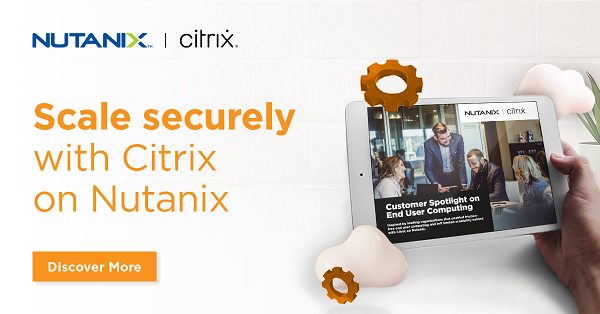Pushed into the mainstream as a reaction to the COVID-19 pandemic, hybrid work — the notion of mixing on-site with virtual work — is maturing and remains the way many businesses are moving into the future. Rather than focusing on where employees should work, organizations are asking hybrid workplaces can unlock a new level of collaboration, innovation and employee satisfaction.
“Engaging and enabling employees through technology has grown even more critical for IT leaders during what is becoming a ‘seismic shift to remote work’ fueled by the pandemic,” wrote Wendy M. Pfeiffer, CIO of Nutanix, in an article in CNBC.
She pointed out that business productivity is heavily reliant on business data. Providing data access to employees in an office setting is one thing, but providing it to employees working remotely requires robust planning and the ability to scale and react quickly to changing needs.
“As employees increasingly interact with technology from their homes, user-friendliness, design, and utility play more important roles in fostering worker productivity,” she said.
A 2022 study by Microsoft found that 80% of remote and hybrid employees believe they’re at least as productive now as they were before going remote or hybrid. And yet, 54% of leaders worry that productivity has been negatively impacted by the shift. The next generation of hybrid work policies and technologies aim to facilitate real-life collaboration and remove challenges people face with working asynchronously from different locations and time zones.
Pfeiffer is helping lead Nutanix’s hybrid-first work policy. She said managers need to help workers to manage through constant change and reduce the energy drain caused by too much context switching. Adopting the right mix of enterprise and consumer technologies, can empower employees and ease any stress that can arise from working away from the office. She said implementing self-service automation can enable knowledge workers to manage, change and configure their own work.
“We need to make sure that anyone in any location, in any time zone, at any place or time, can get access to work in process and can contribute using all of their capabilities,” Pfeiffer said.
Hybrid Work Benefits: Diversity and Innovation
As hybrid-first organizations evolve their tools and processes, they’re looking for ways this workstyle can benefit their company. Without geographical restrictions, and with more work/life flexibility, businesses can cultivate a more diverse workforce.
For example, hybrid work over the course of just two years helped streaming music provider Spotify increase its number of women leaders from 25% to 42% and its number of Black leaders from 12.7% to 18%. Diversity of people translates to the diversity of thought, which increases creative thinking and stimulates ideation.
“When everyone in the room has the same background, experience and stories, they usually all come up with the same ideas,” said Gustavo Razzetti, CEO at Fearless Culture and author of Remote Not Distant: Design a Company Culture That Will Help You Thrive in a Hybrid Workplace.
“When you have people with different origins and experiences, they see the world through different lenses and bring new ideas. If you create psychological safety, people can debate each other, can challenge each other, can build on each other’s ideas. That’s when magic happens and allows people to be more innovative.”
Pfeiffer said building a supportive culture and facilitating easy collaboration with the right tools and processes enables that magic to happen.
“In this hybrid world, if the technology disables or under-enables productivity, then that's a competitive disadvantage for my company and we don't survive,” she said.
“In the end, although technology enables us to work from home, it’s our human spirit that enables us to thrive while doing so,” Pfeiffer said.
Smart Hybrid Work Policies
A hybrid work model must serve both employees and the business. That model needs to be tailored to a company’s unique culture, vision and mission. Insurance company Allstate, for example, allows each of its teams to design the hybrid setup that works best for them.
“For most employees in a hybrid role, office presence will be driven by the nature of their work and team needs on a given day,” the company said in a 2021 post on its recruiting website.
“There may be weeks where an employee is in an Allstate office every day and other weeks where they’re only working from home. There may be times employees might find themselves collaborating virtually with a project team and then deciding to assemble in the office the next day to brainstorm. Others will follow a schedule set by their leaders, making office presence more predictable. This may apply to someone if their role is operational in nature or their team likely benefits from in-person collaboration, onboarding, training and development, or coaching sessions with a front-line leader.”
The key is flexibility.
“Companies need to put a hybrid model in place to support their staff in terms of what works best for themselves — such as time of day and personal commitments — as well as the particular project delivery,” said Gemma Allen, vice president of B2C technology at IDA Ireland, who works with global technology companies that have a presence in Ireland.
Razzetti recommends avoiding the urge to establish an arbitrary number of mandatory days in the office in favor of designing a hybrid model around the work itself. His own team, for example, may work together in person for a day or even a week while in the innovation stage of a project, work remotely on individual tasks for several weeks thereafter and then meet in person again during the final push to completion.
“While we have flexibility to each design our schedule, we also commit to what we call collaboration hours, such as noon to 3 pm, where every team member is available,” Razzetti said. “If you send an email or schedule a meeting, you know your co-worker is working.”
Flexibility is as much about activating employees as it is about appeasing them. Collaborating in a conference room with a whiteboard or brainstorming together during a Zoom call are common ways to sync across a team, but collaboration doesn’t always have to occur in real time to be effective.
To create a strong culture based on teamwork and camaraderie, there needs to be a certain amount of in-person face time, according to Allen. However, she said asynchronous collaboration can also be advantageous, allowing teams to benefit from all perspectives — including from more introverted employees.
“Asynchronous collaboration in a remote setting gives space and autonomy to think,” Allen said.
“Many people feel empowered and build confidence after getting positive feedback on their ideas in remote collaboration. They are often then more likely to be outspoken in in-person settings in the future.”
Ultimately, the goal should be moving to a results-oriented workplace where employees are accountable for what they accomplish instead of where or when they work, suggested Keith Sims, owner of IT services firm Integrity Resource Management.
“You set expectations and metrics, but don’t punish people for getting more done in less time. If someone outperforms others in fewer hours, then I ask them to teach the rest of us their tricks,” Sims said.
New Hybrid Work Technology
If smart policies can unlock the door to successful hybrid work, then smart technology will turn the knob and open it.
Cloud computing is already the foundation for IT environments that support hybrid work. Microsoft Teams and Zoom both utilize the cloud for communication and collaboration amongst hybrid workers. As these video collaboration technologies became more popular during the COVID-19 pandemic, they also brought fatigue and made some interactions awkward. The next generation of cloud-based hybrid work technologies could create a more inclusive experience for both remote and in-person team members.
In 2022, for example, HP launched HP Presence. When remote workers dial into meetings, they often struggle to see and hear their colleagues in the office, which means they can be easily marginalized, excluded and overlooked. HP Presence uses AI-powered tools — cameras that follow and spotlight in-room speakers, for example, and microphones that automatically adjust the sound so remote attendees can be heard — to make meetings better for everyone.
Or there’s Switchboard, which co-founder and CEO Amir Ashkenazi calls a “cloud co-working space purpose-built for remote work.” Instead of videoconferencing and screen sharing, the platform revolves around virtual rooms inside of which users can share documents and run web-based apps like Google Docs and Trello.
“Collaboration tools should combine communication and the applications we use seamlessly,” Ashkenazi told TechCrunch.
“The challenge is really one of workforce behavior, where video conferencing and screen sharing is deeply ingrained in our behaviors. But most workers also realize how inadequate those tools are and want something better.”
Microsoft, meanwhile, is going all-in on the metaverse with Mesh for Microsoft Teams, which combines traditional collaboration tools like virtual meetings and shared documents with emerging technologies like mixed reality and holograms.
An underpinning technology for hybrid work is virtual desktop infrastructure and desktop as a service, which stream apps and data to employees, making it easier for IT teams to update and manage critical business functions and information. On the other hand, artificial intelligence-powered services are quickly moving into businesses to help automate tasks that give employees access to resources or answers to business, benefits or technical questions.
The Future of Hybrid Work is Here
Hybrid work 1.0 focused on control by dictating when, how and with what tools hybrid workers could plug into the workplace. The future of hybrid work is going to look very different.
“I can’t possibly get in the mind of all 7,000 of my workers,” Nutanix CIO Pfeiffer said.
“And particularly, I can’t get in the minds and the constructs of all of the different generations and geographic locations and world cultures who are showing up in my workspace. So instead, I need to provide them with access to configure the tools and the environments and the data that they need to do their jobs in ways that are efficient for them.”
As companies like Nutanix realize what policies and technologies are needed to activate the full benefits of hybrid work, they will focus, instead, on trust, flexibility and culture, which will be the hallmarks of hybrid work 2.0, according to Razzetti.
“The magic of hybrid is scale flexibility,” he said. “And not only allowing people to choose where they work, but also when and how. That’s the beauty.
“When people have the flexibility to design their workday, then they’re becoming more productive, more creative and more committed to their workplace.”
Editor's note: For more on the topic, read Treating Remote Employees Fairly in a Hybrid Workplace by TopTal Insights, featuring interviews with experts from PwC, Gartner and the NeuroLeadership Institute.
Jennifer Goforth Gregory is a contributing writer. Finder her on Twitter @byJenGregory.
© 2023 Nutanix, Inc. All rights reserved. For additional legal information, please go here.







